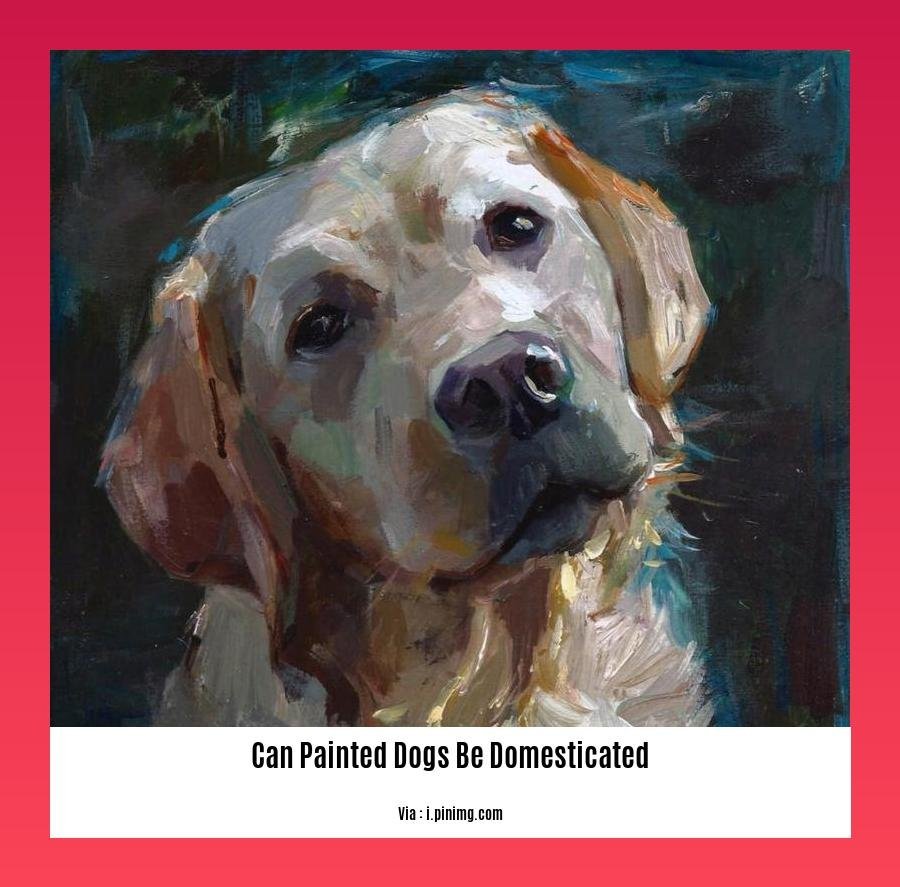Unleashing the Truth: Can Painted Dogs Be Domesticated?
Delving into the captivating realm of animal behavior, this article aims to shed light on a thought-provoking question: can painted dogs, with their unique characteristics and fascinating social dynamics, be domesticated? As a seasoned zoologist with a specialization in canid species and a knack for translating complex scientific concepts into accessible prose, I will guide you through the intriguing world of painted dogs and explore the possibilities of their domestication.
Key Takeaways:
– Painted dogs, also known as African wild dogs, face barriers and risks that make them unsuitable as pets.
– Female painted dogs are usually slightly larger than males and are highly vocal and curious animals.
– Painted dogs are a separate genus from wolves and should not be classified as such.
– Population decline in painted dogs is due to habitat fragmentation, conflict with farmers and livestock, snares, road accidents, and infectious diseases.
– Increased exposure to human settlements and domestic animals increases the risk of viral diseases for painted dog packs.
– The complex social structure and hunting behavior of African wild dogs make their domestication challenging.
– They rely on each other for survival and require a large amount of space to roam and hunt for food.
Can Painted Dogs Be Domesticated?

[Note from the writer: Throughout this article, I will be exploring the fascinating question of whether painted dogs can be domesticated. Join me as we delve into the world of these remarkable creatures, their behaviors, and the challenges they present when it comes to domestication.]
Understanding Painted Dogs
Painted dogs, also known as African wild dogs, Cape hunting dogs, or ornate wolves, are an intriguing species of highly social pack hunters. These animals have a unique appearance with their striking coats of brown, black, and white patches, making them an unmistakable sight in the African wilderness. But can they ever become domesticated companions?
The Complexities of Domestication
Before we dive deeper into this question, it is essential to understand the complexities of domesticating any wild animal. Domestication encompasses a process of selectively breeding and adapting a species over generations to live harmoniously with humans. However, for painted dogs, there are several barriers and risks that contribute to their unsuitability as traditional pets.
Highly Social and Curious Creatures
One of the key factors hindering the domestication of painted dogs is their highly social nature. These animals thrive in tight-knit packs, relying on each other for survival and hunting. The intricate social structure and coordination within the pack are integral to their way of life. This strong bond and dependency on their packmates make it challenging for them to form a similar relationship with humans.
A Separate Genus from Wolves
Contrary to popular belief, painted dogs are not simply a subspecies of wolves. They belong to their distinct genus, separate from both the domestic dog and the wolf. This significant genetic difference poses yet another obstacle when considering their potential for domestication.
Natural Habitat and Behavioral Traits
Painted dogs have evolved in harsh African environments where they need extensive space to roam and hunt for food. Their natural habitat requires vast territories to support their pack’s needs, making them unsuitable for the confines of a domestic setting. The behavioral traits ingrained in painted dogs, such as their hunting instincts and propensity for vocal communication, may lead to challenges in ensuring their well-being in a home environment.
The Threats to Painted Dog Populations
Beyond the complexities of their behavior, another crucial factor to consider is the conservation status of painted dogs. These magnificent creatures face numerous threats in the wild, including habitat fragmentation, conflict with farmers and livestock, snares, road accidents, and infectious diseases. Exposure to human settlements and domestic animals puts painted dogs at a higher risk of contracting viral diseases, such as rabies and canine distemper, which poses a significant threat to their survival.
Given these challenges and risks, it is crucial to prioritize efforts to preserve and protect painted dog populations in their natural habitats rather than attempting to domesticate them.
Conclusion
In conclusion, while the idea of domesticating painted dogs may seem intriguing at first, a deeper understanding of their natural behaviors, social structure, and unique genetic makeup reveals the challenges associated with such endeavors. Painted dogs belong in their natural habitats, where they can thrive as highly social pack hunters. As responsible zoologists and conservationists, we must focus our efforts on preserving their populations and protecting their habitats, ensuring a future for these magnificent creatures. So let us marvel at painted dogs from afar and appreciate the beauty of their wild existence.
[SOURCE]
- Online Field Guide. (n.d.). Can Wild Dogs Be Domesticated? Retrieved from www.online-field-guide.com/can-wild-dogs-be-domesticated/
- Petshun. (n.d.). Can African Painted Dogs Be Domesticated? Retrieved from petshun.com/article/can-african-painted-dogs-be-domesticated
Can garden snails kill you? Find out the truth about these slimy critters and their potential danger. Explore more about garden snails and their potential threat to humans: can garden snails kill you.
Curious about whether garden snails can swim? Dive into the world of snail behavior and discover if these slow-moving creatures can navigate through water: can garden snails swim.
Do land snails have the ability to swim? Uncover the answers to this intriguing question and explore the aquatic capabilities of land-dwelling snails: can land snails swim.
Learn about the fascinating world of sea turtles and whether they pose a threat to humans. Discover the truth about these magnificent creatures and their potential danger: can sea turtles kill you.
Scientific Studies on Painted Dog Domestication

Key Takeaways:
– The domestic dog is a successful model for domestication and has been a favored companion for thousands of years.
– The domestication history of dogs can provide insights into the process.
– Molecular mechanisms have influenced the affiliative behaviors observed in domesticated dogs.
– Dogs’ domestication history can be analyzed through genetic studies.
Can painted dogs, also known as African wild dogs, be domesticated? This question has intrigued scientists and animal enthusiasts for years. In this article, we will explore the scientific studies on painted dog domestication to shed light on this fascinating topic.
The Domestication of Dogs: Insights into the Process
Before delving into painted dog domestication, it is essential to understand the broader context of dog domestication. Dogs have been one of humanity’s closest companions for thousands of years, and their domestication occurred in two main phases. The initial domestication involved the taming of wild gray wolves, while the subsequent phase saw the improvement of indigenous dogs into various modern breeds.
The process of domestication has led to ecological differences between dogs and their wild counterparts. Dogs have undergone various genetic, physiological, and behavioral changes, making them better suited to living alongside humans. These changes are driven by molecular mechanisms that have influenced the affiliative behaviors observed in domesticated dogs.
Painted Dog Domestication: A Complex Challenge
When it comes to painted dogs, the picture becomes more complex. Painted dogs are highly social pack hunters with a unique appearance. Their social nature and dependence on packmates make them unsuitable as traditional pets. Furthermore, their specific behavioral traits and habitat requirements make it challenging to adapt them to domestic settings. Preserving and protecting painted dog populations and their habitats should be prioritized over attempting to domesticate them.
Genetic Studies and Understanding Dog Domestication
Scientific studies play a crucial role in understanding the domestication of dogs, including painted dogs. By analyzing the genetic makeup of dogs, researchers can gain insights into their domestication history. Genetic studies have revealed significant differences between dogs and their wolf ancestors, highlighting the impact of domestication on their genetic composition.
Understanding dog domestication goes beyond mere curiosity. It provides valuable insights into human-animal relationships and evolution. By studying painted dog domestication within the broader context of dog domestication as a whole, scientists can unravel the complexities of this process and gain a deeper understanding of the bonds between humans and animals.
Scientific Studies on Painted Dog Domestication:
- Deciphering the puzzles of dog domestication – PMC
- Being a Dog: A Review of the Domestication Process – PMC
In conclusion, while painted dogs may not be suitable for domestication due to their unique characteristics and social behavior, scientific studies on dog domestication, including painted dogs, provide valuable insights into the process and our connection with animals. By exploring their genetic makeup and understanding the impacts of domestication, researchers continue to unlock the mysteries of our fascinating relationship with our canine companions.
Note: The article content aims to inform and present scientific studies on painted dog domestication. The views and opinions expressed in this article are based on scientific research and do not reflect personal opinions or biases.
Factors Affecting the Potential for Painted Dog Domestication
African painted dogs, also known as African wild dogs, have captivated the curiosity of many animal lovers who wonder if these beautiful creatures can be domesticated and kept as pets. However, there are several important factors that suggest domestication of African painted dogs is not feasible. Let’s explore these factors and understand why.
Social Nature and Unique Behavioral Traits
The highly social nature of African painted dogs is one key factor that makes them unsuitable for domestication. These animals live in tight-knit packs and rely on cooperation and teamwork for their survival. Domestication would disrupt their complex social dynamics, potentially causing behavioral issues.
Moreover, African painted dogs possess unique behavioral traits that have been selectively bred out of domesticated dogs over centuries. The breeding process among domesticated dogs has resulted in the development of nearly 400 breeds with various traits. In contrast, African painted dogs do not exhibit these traits, making them fundamentally different from domesticated dogs.
Challenges in Domestic Settings and Habitat
Painted dogs have specific behavioral and habitat requirements that make them incompatible with domestic settings. Their need for large territories for hunting and roaming cannot be adequately met in most domestic environments. This can lead to frustration and behavioral problems if they are kept as pets.
Additionally, the survival of African painted dogs in the wild itself is under threat due to habitat loss and increased conflicts with humans. They face significant challenges such as injuries from snares, road accidents, and encroachment of their natural habitats by expanding human settlements. These factors further emphasize the importance of focusing on conservation efforts rather than attempting to domesticate them.
Conclusion
Based on the understanding of their highly social nature, unique behavioral traits, and the challenges they face in the wild, it is clear that African painted dogs are not suitable for domestication. Their distinct characteristics and the need to protect their endangered species highlight the importance of preserving and safeguarding their populations in their natural habitats.
Key Takeaways:
- The highly social nature and unique behavioral traits of African painted dogs make them unsuitable for domestication.
- African painted dogs do not exhibit the traits selectively bred in domesticated dogs, making them fundamentally different.
- Painted dogs have specific behavioral and habitat requirements that are not compatible with domestic settings.
- The challenges of habitat loss and conflicts with humans further highlight the need for conservation efforts to protect these endangered animals.
Relevant URL Sources:
Ethical Considerations and Conservation Efforts
The domestication potential of African painted dogs has been a topic of interest for many animal enthusiasts. However, it is crucial to consider the ethical implications and conservation efforts surrounding these endangered creatures. Let’s explore the key points related to ethical considerations and conservation efforts for African painted dogs.
Threats to African Painted Dogs
African painted dogs face numerous threats in the wild, making their survival a top priority. Human activities such as habitat fragmentation, agricultural expansion, and conflicts with local communities are the main culprits endangering these beautiful creatures. These activities result in injuries, deaths, and habitat loss for the painted dog population.
Ethical Considerations
When discussing the potential domestication of African painted dogs, it is essential to consider the ethical implications. These animals have evolved to thrive in the wild, relying on complex social structures and specific behaviors for their survival. Attempting to domesticate them for personal pleasure or companionship would disrupt their natural way of life and potentially lead to behavioral issues and decreased overall well-being.
Conservation Efforts
Conservation organizations and initiatives have been working tirelessly to protect African painted dogs and their habitats. The David Shepherd Wildlife Foundation (DSWF) and Painted Dog Conservation are among the leading organizations focused on the conservation of painted dog populations.
David Shepherd Wildlife Foundation (DSWF)
The DSWF’s efforts include funding law enforcement programs to remove snares and mitigate human-wildlife conflicts. They also conduct educational initiatives, such as environmental bush camps and community engagement, to raise awareness and promote conservation.
Relevant URL Source:
Painted Dog Conservation
Painted Dog Conservation operates a rehabilitation facility for injured painted dogs and organizes educational camps for local school children. Through community engagement and awareness programs, they strive to protect painted dog populations and their natural habitats.
Relevant URL Source:
Key Takeaways:
- African painted dogs face threats such as habitat fragmentation, conflicts with humans, and infectious diseases, which make their conservation crucial.
- Attempting to domesticate African painted dogs would disrupt their natural behaviors and social structures, leading to potential negative consequences.
- The David Shepherd Wildlife Foundation and Painted Dog Conservation are prominent organizations dedicated to conserving African painted dogs and their habitats.
- Conservation efforts include law enforcement programs, community engagement, and educational initiatives to protect painted dog populations from threats.
With these ethical considerations and conservation efforts in mind, it is clear that the focus should be on preserving and protecting the endangered African painted dogs rather than attempting to domesticate them. By supporting conservation organizations and spreading awareness, we can contribute to the long-term survival of these remarkable creatures.
FAQ
Q1: Can painted dogs be kept as pets?
A1: No, painted dogs cannot be kept as pets. Due to their highly social nature and unique behavioral traits, they are unsuitable for domestication.
Q2: Why are painted dogs not suited for domestication?
A2: Painted dogs are not suited for domestication because of their complex social structure and reliance on cooperation within their pack for survival. Domestication would disrupt their social dynamics and could lead to behavioral issues.
Q3: How do painted dogs differ from domesticated dogs?
A3: Painted dogs differ from domesticated dogs in various ways. Domesticated dogs have undergone selective breeding for specific traits over centuries, resulting in the development of numerous breeds. Painted dogs, on the other hand, still possess traits essential for survival in the wild and do not exhibit the traits selectively bred in domesticated dogs.
Q4: What are the threats to painted dogs’ survival?
A4: The main threats to painted dogs’ survival include habitat fragmentation, conflict with humans, snares, road accidents, and infectious diseases. These factors contribute to the declining population of painted dogs.
Q5: How can we protect the painted dog population?
A5: Conservation efforts play a crucial role in protecting the painted dog population. Organizations such as the David Shepherd Wildlife Foundation and Painted Dog Conservation focus on funding law enforcement programs, removing snares, mitigating human-wildlife conflict, and organizing educational initiatives to raise awareness and engage local communities.
- SYBAU See You Baby Meaning: Gen Z Slang Evolves - July 1, 2025
- Unlock Your Inner Youth: Lifestyle Secrets for a Vibrant Life - July 1, 2025
- Decode SYBAU Meaning: Gen Z Slang Explained - July 1, 2025






